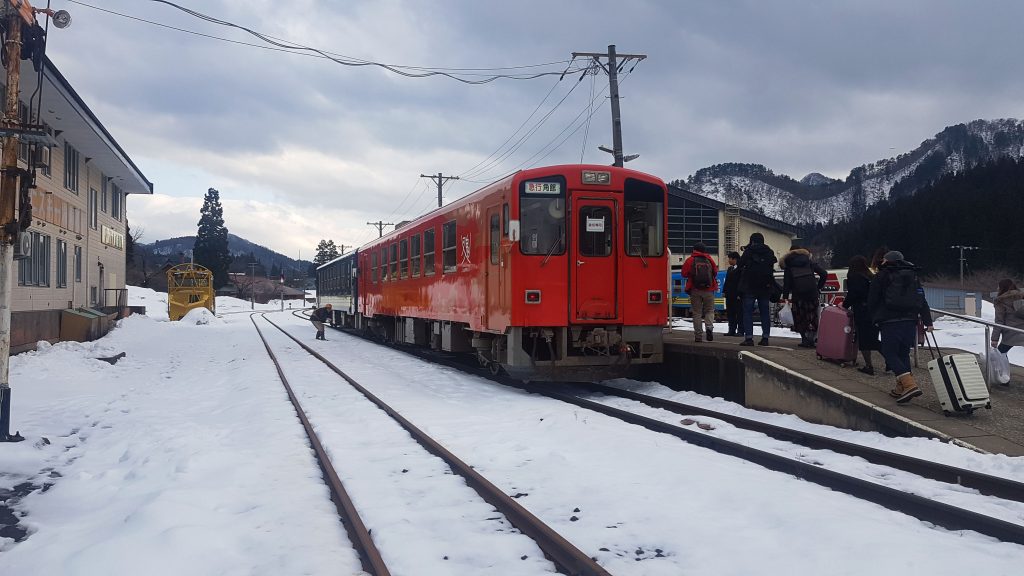
Charms of Akita and Iwate
I was whisked away to Northern Japan for a few short days this March. Thanks to a concerted effort by small businesses scattered about the mountains of Iwate and Akita, some tourism coordinators, and a very good bus driver, I saw some of the best sights the region has to offer. Today I’ll be giving you the highlights of the trip so you know what to check out when you’re in the area.
Miso Chaya: your one-stop shop for snacks, meals, and everything miso

This business not only makes its miso from scratch, but they teach their hard-earned secrets in their miso-making classes. The beginner’s course is 3000 yen and is held once a month between October and June. They might give you a peek in their storehouse during the off-season if you asked nicely enough.

If you don’t have time to make miso, you can still buy some of their expertly-crafted miso and koji. The lunch they offer gives you a sample of everything for only 800 yen. They also sell a wide variety of products including amazake, pickles, sauces, and strange desserts. Have you ever wondered what miso soft serve or koji pudding tastes like? They’re better than you might think!
Kosaka Town: historical influence attracting crowds and tech companies

Many of Japan’s cities have seen wealth and fame throughout history. For Kosaka, their prosperity has continued since the discovery of its large deposits of copper, lead, zinc, gold, and silver in the early 1800’s. Kosaka is now the leader of metal salvage technology and recovers about $42,000 USD of gold every day.
Its old town office which looks like a three-story mansion has reopened as a museum. You can learn about Kosaka’s ages of prosperity while walking through an international architectural marvel. All of the building’s design components came from Europe and the Middle East except for the ceiling, which has the same design found in most Japanese castles. No nails were used in the construction process!

Across the yard from the office building stands Japan’s oldest wooden playhouse. Famous Japanese actors are featured in place twice a day between April and October. From December and March, guests are welcome to try on costumes in the makeup rooms for free.
http://www.akita-ecotown.com/english/kosaka_zim.html
Odate Wappa Building: build a bento to treasure for life
Odate, Akita prefecture
The finest souvenirs are the ones you make yourself. One of Akita’s famous crafts is magewappa. These boxes and cups are simple, refined, and what Marie Kondo would say spark joy. Why not make one for yourself in this craft experience? It’s 5000 yen per person and it takes about 2 hours from start to finish. There’s enough room for a group of roughly 20 people to participate at once. You’ll also learn how to keep your creation looking beautiful for decades to come. There’s also a café next door which uses a few magewappa items to serve its fare. You can always try using the containers here before deciding to own some!

Hikage Onsen: bathe in an abundance of minerals

As an avid onsen enthusiast, I can say for certain that this ryokan experience is magical. Your arrival is met by five women beating taiko drums and big, fluffy Akita inu. From there, you are lead to a beautiful lobby with amenities before entering your very own suite for the night.
Hikage onsen has healed the wounds of soldiers during WWII and continues to help those suffering from rashes, eczema, arthritis, menopausal symptoms, and digestive disorders. I wish I lived nearby because it really helped my eczema! There are so many minerals in the water here that the ryokan needs to change its baths’ pipes once every month or two. Just imagine what a 20-minute soak could do for you.
The views are equally breath-taking, especially during snowy months. I highly recommend taking advantage of one of the private outdoor baths for the full experience. The hotel was renovated about two years ago but there’s still a sense of antiquity in the air. At times, it’s even a little spooky.

The food is a real sight to behold. Photos don’t do it justice. You’ll get everything you can hope for and more. As a guest in the winter, I was treated to a local fish known as hata hata. This deep-sea dweller hides in the sand most of its life and the two I was served were females packed full of roe. I’d recommend searching for other delicacies unless chewing hard eggs is something you’d like to try.

Taiko Museum: a “hit” for children
It’s not every day you get to see something in Japan break a Guinness World Record for being big. This museum’s 6- and 3-meter tall drums are paraded around the town in processions of dancers during the local summer festival. The reason these drums got so big was because the town’s north and south neighborhoods have had a long history of competing with one another for having the largest drum that year. That tradition has proven much more peaceful than their original race to be the first to give offerings to the local shrine.
Beyond the huge taiko drums is a fun, interactive museum with an international drum collection. Most of the drums can be used by attendees. It’s a great place to play and get a little silly, and the admission fee of 420 yen is worth it. There’s also a store in the same parking lot which sells souvenirs and snacks. If you haven’t tried butter mochi yet, I suggest you take this opportunity to buy some. The only complaint is that the lighting isn’t very good for taking photos. You’ll find most of them look green.
http://www.city.kitaakita.akita.jp/kankou/category/kankou_shisetsu/takanosu/001.html
Matagi Museum: Akita’s bear hunters

The Matagi have been hunting bears in Akita’s forests since at least the 14th century. Their stories, history, tools, and legends are being preserved in this museum. Its founder is a gentleman with a passion for teaching the world about Matagi. He is also fond of the local bears in many ways. The museum’s restaurant even has bear meat on it! What is perhaps crazier is that he convinced us of the medicinal properties of bear stomach. He generously offered us some shavings and let us taste it for ourselves before giving us a full tour of the premises. Although it was extremely bitter, it seemed we all felt a bit refreshed after having our share. For medicine that costs 10,000 yen per gram, I really hope our imaginations weren’t playing tricks on us.

Moreover, visitors can enjoy a taste of traditional Matagi bear stew. I’m sure you can find bear stew in a chic part of Tokyo, but here you can eat it with an exquisite view of snowflakes tumbling gently to the ground in winter. Who knows how fresh exotic meat in Tokyo is anyway? The wild bears have a very healthy diet and their meat is rich in oils and fats. It’s very tender and has a light taste reminiscent of beef. There are other meals available for the less adventurous.
Akita Nairiku Jukan Railway

The finale of my trip was a ride along a once-abandoned railroad which stops at a shinkansen station. Train travel is the best way to end a trip because it brings you close to nature without any of the footwork.

The interior of the train is very unusual. Riders sit atop pillows on tatami flooring. It gives the feeling of classic Japan while gliding through the countryside in a dream-state. The Nairiku Jukan railway is a perfect blend of farmland, forest, and rocky river.

















If you like this article!